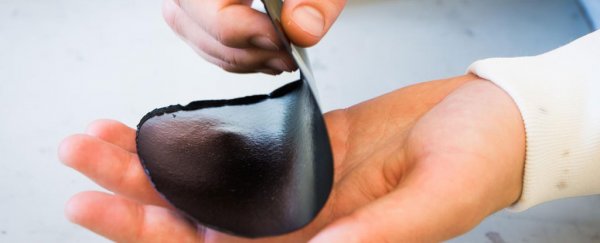Scientists in Sweden have developed what they call "power paper" – a thin, paper-like material with a remarkable capacity to store energy.
Just one sheet of the material measuring 15 centimetres in diameter and less than 0.5 millimetre thick can store 1 farad of electrical capacitance, which is about the same as many supercapacitors used in electric devices today.
The material, which is made from nanocellulose and a conductive polymer, can be used then recharged, lasting for hundreds of charge cycles. And best of all, it only takes a few seconds to power up again.
"Thin films that function as capacitors have existed for some time," said Xavier Crispin, a researcher from Linköping University's Laboratory of Organic Electronics. "What we have done is to produce the material in three dimensions. We can produce thick sheets."
The researchers' material looks like black paper, but to the touch, has a more plasticky feel. Nonetheless, it exhibits other paper-like qualities too, such as strength, as demonstrated by its ability to be folded into origami shapes (the researchers apparently amused themselves by making an origami swan!).
The team created the sheets by breaking down cellulose fibres using high-pressure water. These fibres measure just 20 nanometres in diameter, and are added to a water solution containing an electrically charged polymer. The polymer then forms a thin coating over the fibres.
"The covered fibres are in tangles, where the liquid in the spaces between them functions as an electrolyte," said one of the team, Jesper Edberg. The full process is described in Advanced Science.
The material, which the researchers claim sets new records for simultaneous conductivity for ions and electrons, could have a significant impact on how we store charge in small devices, and with further research might even be able to serve higher-capacity power needs.
Unlike the batteries and capacitors we currently use – which use large amounts of metal and often contain toxic chemicals – the power paper is made from simple materials: renewable cellulose and readily available polymer.
According to the researchers, the paper is light, requires no dangerous chemicals or heavy metals, and is waterproof to boot. The one challenge is developing an industrial process to manufacture it on a large scale.
Like regular pulp paper, the material has to be dehydrated to make the sheeting. If the team can solve this puzzle, possibly with the help of commercial partners, power paper could be something we see a lot more of in the future.
